Analysing Ryanair's Organisational Behaviour: A Comprehensive Report
VerifiedAdded on 2023/01/18
|16
|5689
|71
Report
AI Summary
This report provides an in-depth analysis of Ryanair's organisational behaviour, examining various aspects of its management strategies. It begins by introducing Ryanair and its operational context, highlighting the company's focus on low-cost flights. The main body of the report delves into Handy's model of organisational culture, applying it to Ryanair and discussing power, role, task, and person cultures. It also explores French and Raven's power types, including legitimate, reward, coercive, informational, expert, and referent power, and their implications within the airline. The report further investigates the political behaviour of managers, defining organisational politics and mapping the political terrain within Ryanair. Additionally, it examines motivation theories, differentiating between extrinsic and intrinsic motivation, and focusing on Maslow's hierarchy of needs to understand employee motivation. The report concludes by summarizing the key findings and providing a comprehensive overview of Ryanair's organizational dynamics.
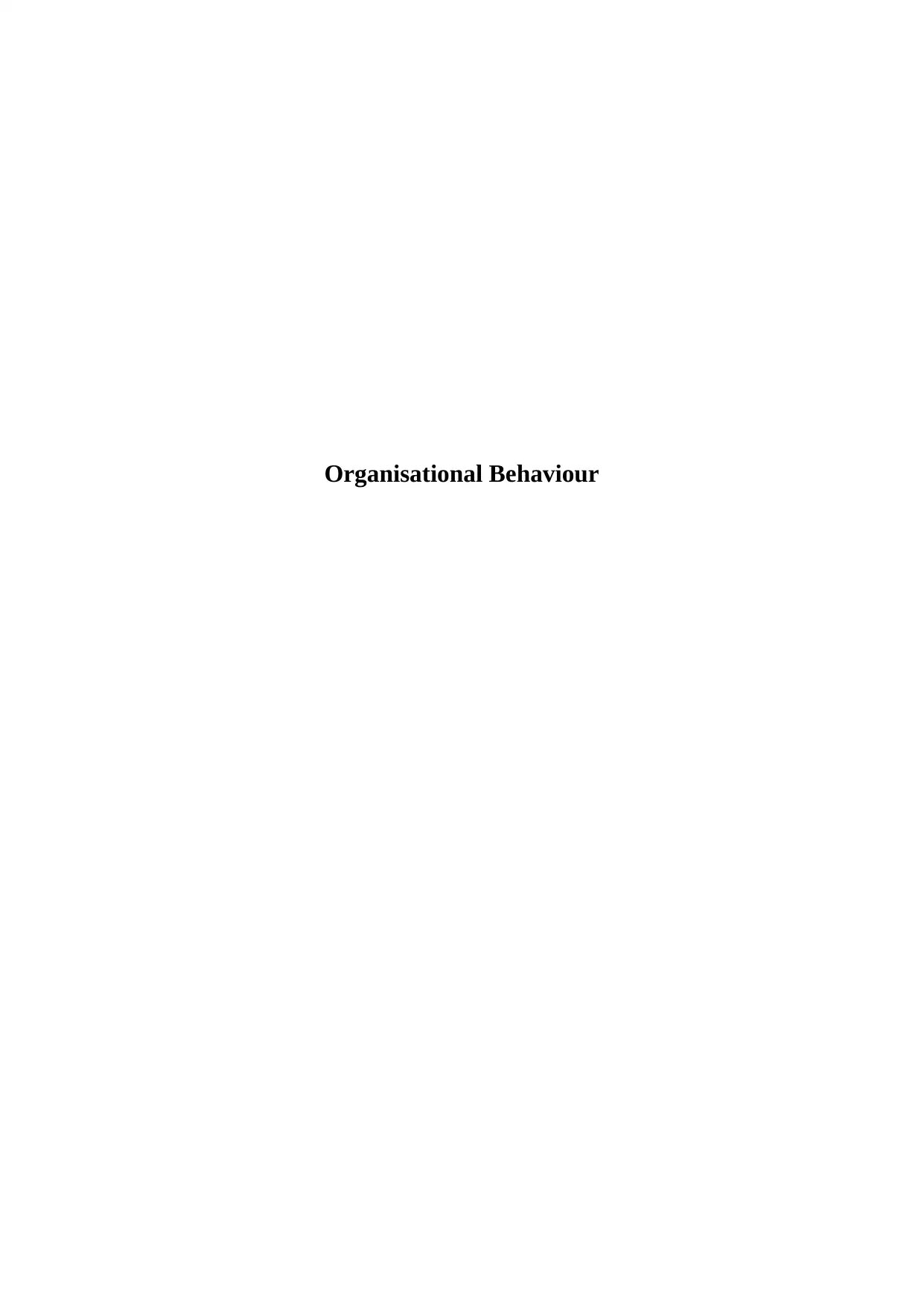
Organisational Behaviour
Paraphrase This Document
Need a fresh take? Get an instant paraphrase of this document with our AI Paraphraser
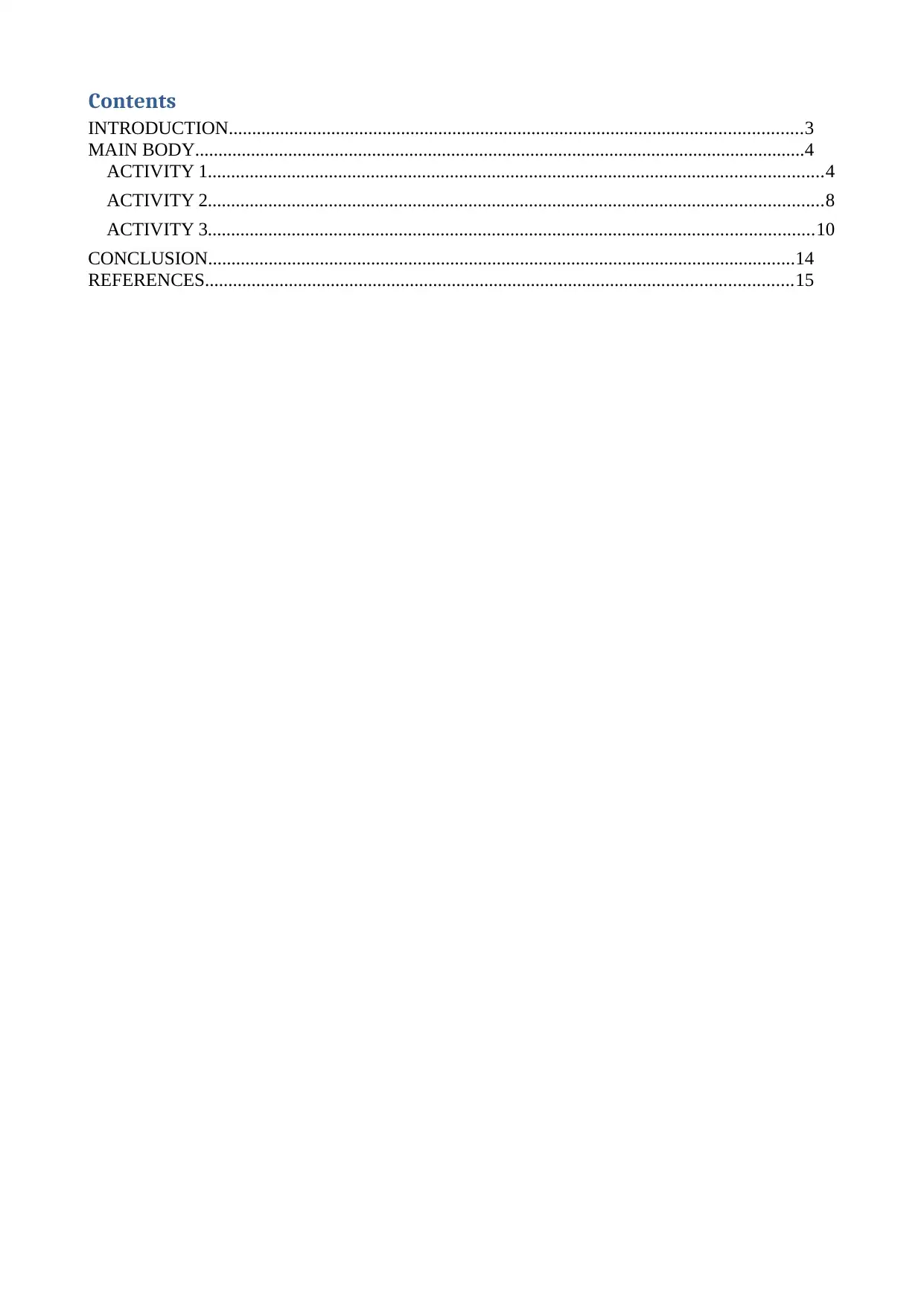
Contents
INTRODUCTION...........................................................................................................................3
MAIN BODY...................................................................................................................................4
ACTIVITY 1....................................................................................................................................4
ACTIVITY 2....................................................................................................................................8
ACTIVITY 3..................................................................................................................................10
CONCLUSION..............................................................................................................................14
REFERENCES..............................................................................................................................15
INTRODUCTION...........................................................................................................................3
MAIN BODY...................................................................................................................................4
ACTIVITY 1....................................................................................................................................4
ACTIVITY 2....................................................................................................................................8
ACTIVITY 3..................................................................................................................................10
CONCLUSION..............................................................................................................................14
REFERENCES..............................................................................................................................15
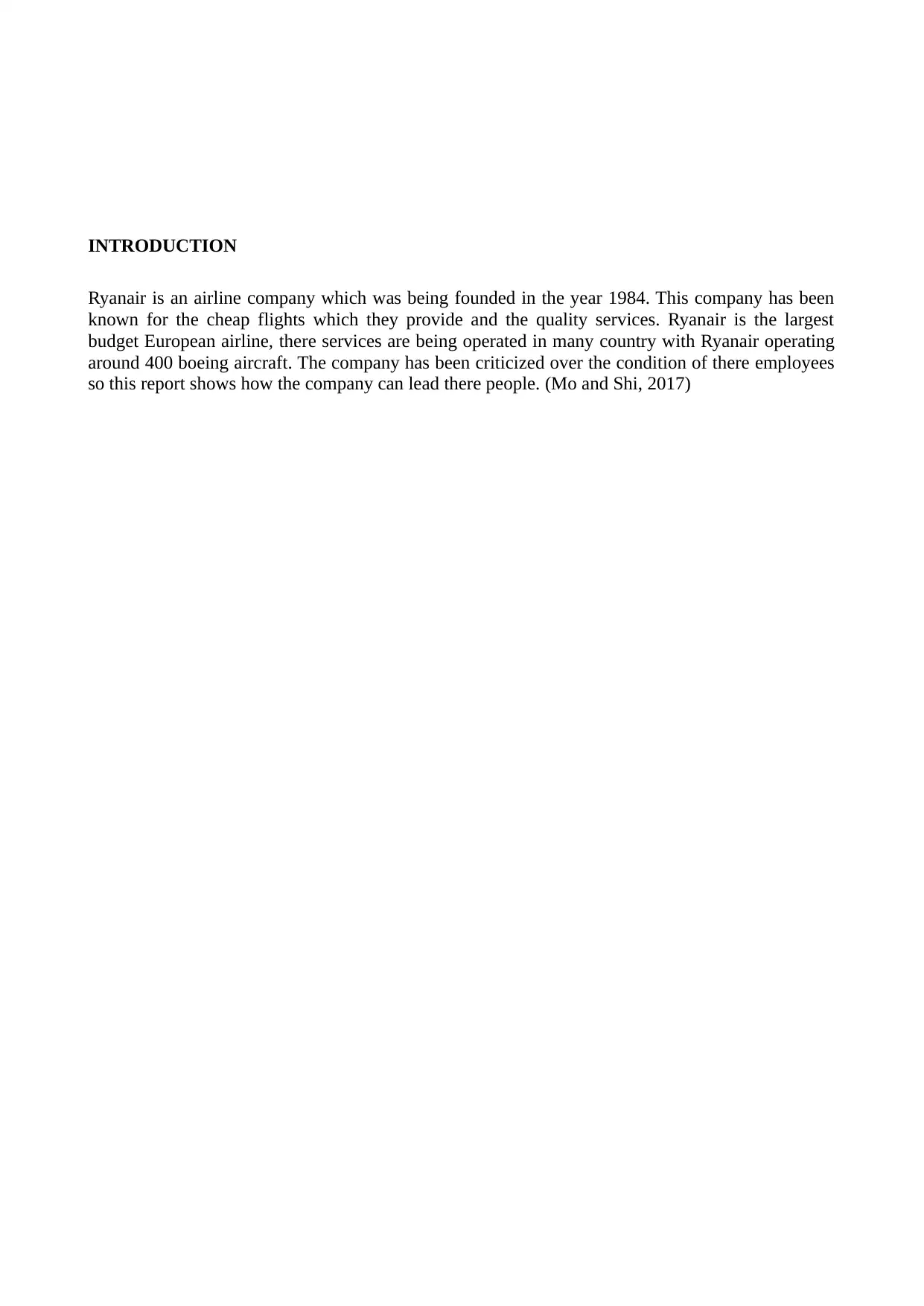
INTRODUCTION
Ryanair is an airline company which was being founded in the year 1984. This company has been
known for the cheap flights which they provide and the quality services. Ryanair is the largest
budget European airline, there services are being operated in many country with Ryanair operating
around 400 boeing aircraft. The company has been criticized over the condition of there employees
so this report shows how the company can lead there people. (Mo and Shi, 2017)
Ryanair is an airline company which was being founded in the year 1984. This company has been
known for the cheap flights which they provide and the quality services. Ryanair is the largest
budget European airline, there services are being operated in many country with Ryanair operating
around 400 boeing aircraft. The company has been criticized over the condition of there employees
so this report shows how the company can lead there people. (Mo and Shi, 2017)
⊘ This is a preview!⊘
Do you want full access?
Subscribe today to unlock all pages.

Trusted by 1+ million students worldwide
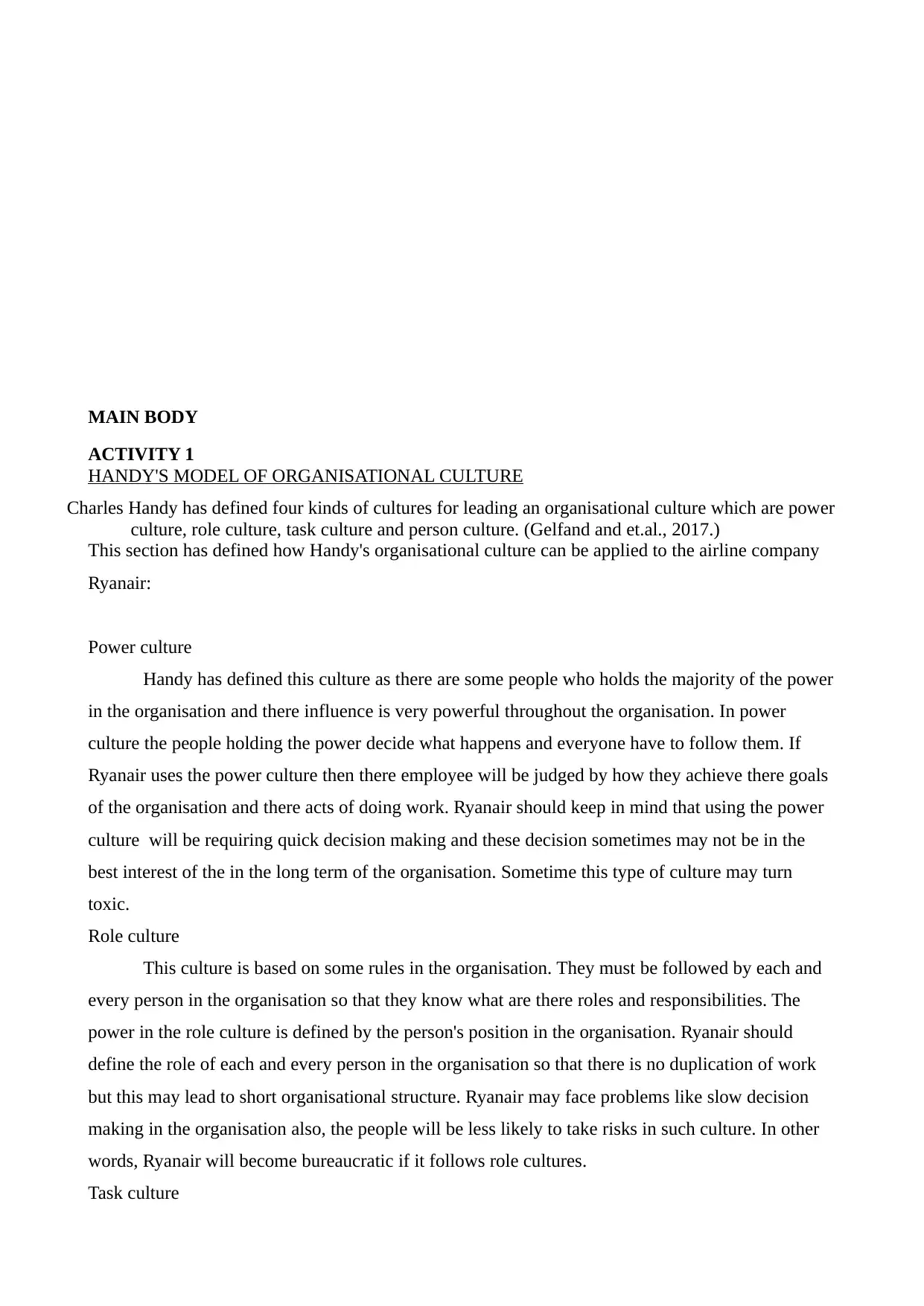
MAIN BODY
ACTIVITY 1
HANDY'S MODEL OF ORGANISATIONAL CULTURE
Charles Handy has defined four kinds of cultures for leading an organisational culture which are power
culture, role culture, task culture and person culture. (Gelfand and et.al., 2017.)
This section has defined how Handy's organisational culture can be applied to the airline company
Ryanair:
Power culture
Handy has defined this culture as there are some people who holds the majority of the power
in the organisation and there influence is very powerful throughout the organisation. In power
culture the people holding the power decide what happens and everyone have to follow them. If
Ryanair uses the power culture then there employee will be judged by how they achieve there goals
of the organisation and there acts of doing work. Ryanair should keep in mind that using the power
culture will be requiring quick decision making and these decision sometimes may not be in the
best interest of the in the long term of the organisation. Sometime this type of culture may turn
toxic.
Role culture
This culture is based on some rules in the organisation. They must be followed by each and
every person in the organisation so that they know what are there roles and responsibilities. The
power in the role culture is defined by the person's position in the organisation. Ryanair should
define the role of each and every person in the organisation so that there is no duplication of work
but this may lead to short organisational structure. Ryanair may face problems like slow decision
making in the organisation also, the people will be less likely to take risks in such culture. In other
words, Ryanair will become bureaucratic if it follows role cultures.
Task culture
ACTIVITY 1
HANDY'S MODEL OF ORGANISATIONAL CULTURE
Charles Handy has defined four kinds of cultures for leading an organisational culture which are power
culture, role culture, task culture and person culture. (Gelfand and et.al., 2017.)
This section has defined how Handy's organisational culture can be applied to the airline company
Ryanair:
Power culture
Handy has defined this culture as there are some people who holds the majority of the power
in the organisation and there influence is very powerful throughout the organisation. In power
culture the people holding the power decide what happens and everyone have to follow them. If
Ryanair uses the power culture then there employee will be judged by how they achieve there goals
of the organisation and there acts of doing work. Ryanair should keep in mind that using the power
culture will be requiring quick decision making and these decision sometimes may not be in the
best interest of the in the long term of the organisation. Sometime this type of culture may turn
toxic.
Role culture
This culture is based on some rules in the organisation. They must be followed by each and
every person in the organisation so that they know what are there roles and responsibilities. The
power in the role culture is defined by the person's position in the organisation. Ryanair should
define the role of each and every person in the organisation so that there is no duplication of work
but this may lead to short organisational structure. Ryanair may face problems like slow decision
making in the organisation also, the people will be less likely to take risks in such culture. In other
words, Ryanair will become bureaucratic if it follows role cultures.
Task culture
Paraphrase This Document
Need a fresh take? Get an instant paraphrase of this document with our AI Paraphraser
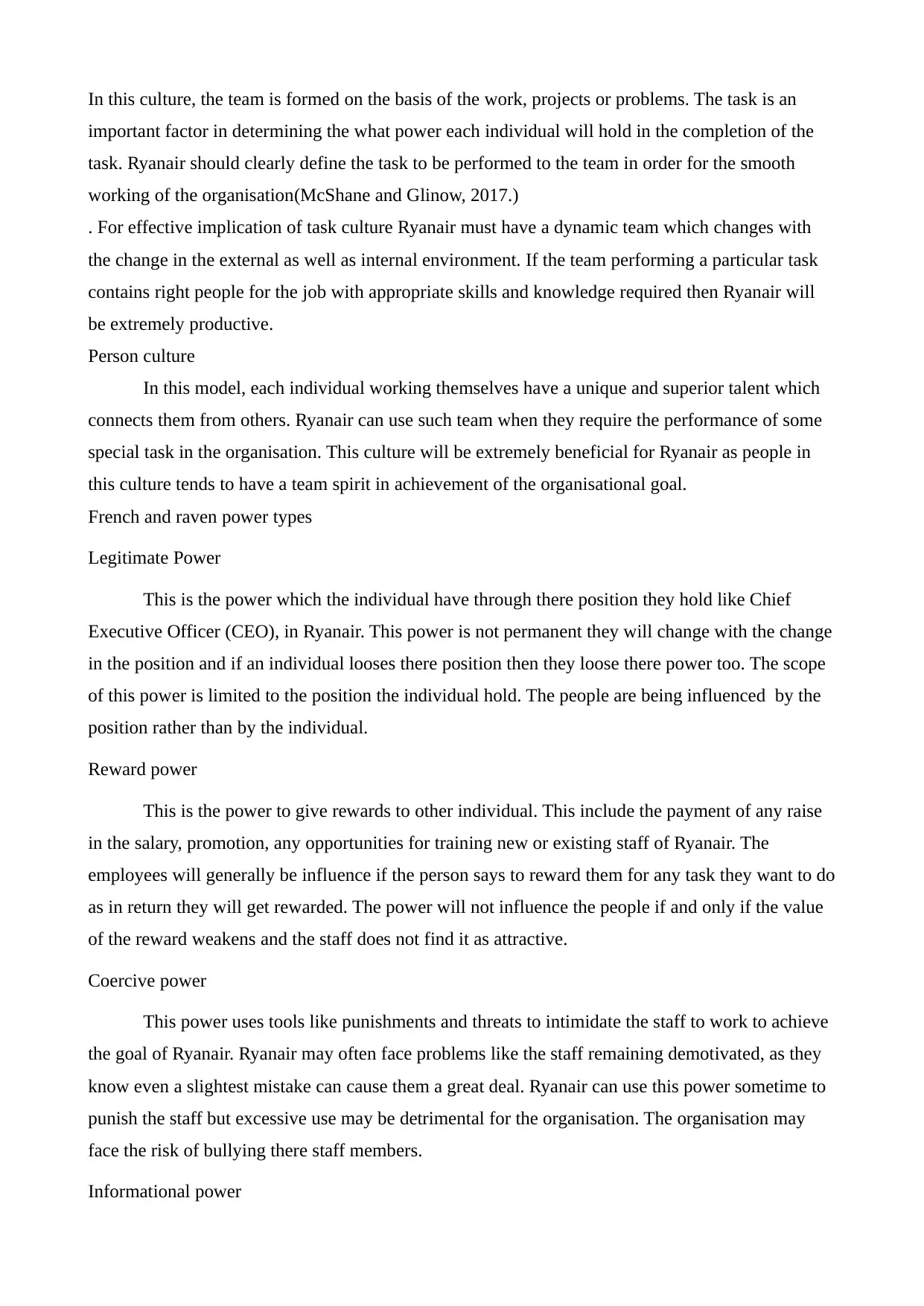
In this culture, the team is formed on the basis of the work, projects or problems. The task is an
important factor in determining the what power each individual will hold in the completion of the
task. Ryanair should clearly define the task to be performed to the team in order for the smooth
working of the organisation(McShane and Glinow, 2017.)
. For effective implication of task culture Ryanair must have a dynamic team which changes with
the change in the external as well as internal environment. If the team performing a particular task
contains right people for the job with appropriate skills and knowledge required then Ryanair will
be extremely productive.
Person culture
In this model, each individual working themselves have a unique and superior talent which
connects them from others. Ryanair can use such team when they require the performance of some
special task in the organisation. This culture will be extremely beneficial for Ryanair as people in
this culture tends to have a team spirit in achievement of the organisational goal.
French and raven power types
Legitimate Power
This is the power which the individual have through there position they hold like Chief
Executive Officer (CEO), in Ryanair. This power is not permanent they will change with the change
in the position and if an individual looses there position then they loose there power too. The scope
of this power is limited to the position the individual hold. The people are being influenced by the
position rather than by the individual.
Reward power
This is the power to give rewards to other individual. This include the payment of any raise
in the salary, promotion, any opportunities for training new or existing staff of Ryanair. The
employees will generally be influence if the person says to reward them for any task they want to do
as in return they will get rewarded. The power will not influence the people if and only if the value
of the reward weakens and the staff does not find it as attractive.
Coercive power
This power uses tools like punishments and threats to intimidate the staff to work to achieve
the goal of Ryanair. Ryanair may often face problems like the staff remaining demotivated, as they
know even a slightest mistake can cause them a great deal. Ryanair can use this power sometime to
punish the staff but excessive use may be detrimental for the organisation. The organisation may
face the risk of bullying there staff members.
Informational power
important factor in determining the what power each individual will hold in the completion of the
task. Ryanair should clearly define the task to be performed to the team in order for the smooth
working of the organisation(McShane and Glinow, 2017.)
. For effective implication of task culture Ryanair must have a dynamic team which changes with
the change in the external as well as internal environment. If the team performing a particular task
contains right people for the job with appropriate skills and knowledge required then Ryanair will
be extremely productive.
Person culture
In this model, each individual working themselves have a unique and superior talent which
connects them from others. Ryanair can use such team when they require the performance of some
special task in the organisation. This culture will be extremely beneficial for Ryanair as people in
this culture tends to have a team spirit in achievement of the organisational goal.
French and raven power types
Legitimate Power
This is the power which the individual have through there position they hold like Chief
Executive Officer (CEO), in Ryanair. This power is not permanent they will change with the change
in the position and if an individual looses there position then they loose there power too. The scope
of this power is limited to the position the individual hold. The people are being influenced by the
position rather than by the individual.
Reward power
This is the power to give rewards to other individual. This include the payment of any raise
in the salary, promotion, any opportunities for training new or existing staff of Ryanair. The
employees will generally be influence if the person says to reward them for any task they want to do
as in return they will get rewarded. The power will not influence the people if and only if the value
of the reward weakens and the staff does not find it as attractive.
Coercive power
This power uses tools like punishments and threats to intimidate the staff to work to achieve
the goal of Ryanair. Ryanair may often face problems like the staff remaining demotivated, as they
know even a slightest mistake can cause them a great deal. Ryanair can use this power sometime to
punish the staff but excessive use may be detrimental for the organisation. The organisation may
face the risk of bullying there staff members.
Informational power
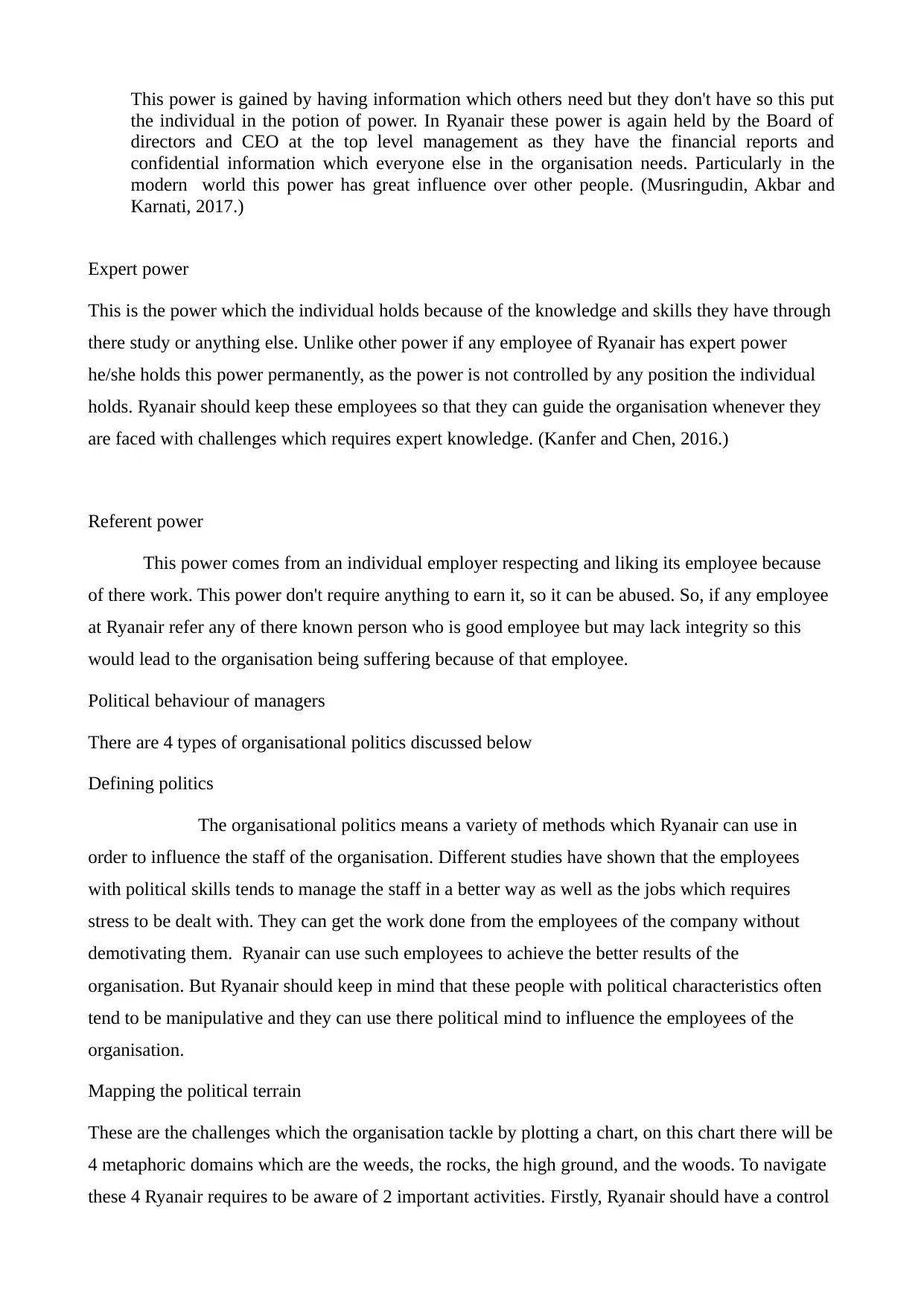
This power is gained by having information which others need but they don't have so this put
the individual in the potion of power. In Ryanair these power is again held by the Board of
directors and CEO at the top level management as they have the financial reports and
confidential information which everyone else in the organisation needs. Particularly in the
modern world this power has great influence over other people. (Musringudin, Akbar and
Karnati, 2017.)
Expert power
This is the power which the individual holds because of the knowledge and skills they have through
there study or anything else. Unlike other power if any employee of Ryanair has expert power
he/she holds this power permanently, as the power is not controlled by any position the individual
holds. Ryanair should keep these employees so that they can guide the organisation whenever they
are faced with challenges which requires expert knowledge. (Kanfer and Chen, 2016.)
Referent power
This power comes from an individual employer respecting and liking its employee because
of there work. This power don't require anything to earn it, so it can be abused. So, if any employee
at Ryanair refer any of there known person who is good employee but may lack integrity so this
would lead to the organisation being suffering because of that employee.
Political behaviour of managers
There are 4 types of organisational politics discussed below
Defining politics
The organisational politics means a variety of methods which Ryanair can use in
order to influence the staff of the organisation. Different studies have shown that the employees
with political skills tends to manage the staff in a better way as well as the jobs which requires
stress to be dealt with. They can get the work done from the employees of the company without
demotivating them. Ryanair can use such employees to achieve the better results of the
organisation. But Ryanair should keep in mind that these people with political characteristics often
tend to be manipulative and they can use there political mind to influence the employees of the
organisation.
Mapping the political terrain
These are the challenges which the organisation tackle by plotting a chart, on this chart there will be
4 metaphoric domains which are the weeds, the rocks, the high ground, and the woods. To navigate
these 4 Ryanair requires to be aware of 2 important activities. Firstly, Ryanair should have a control
the individual in the potion of power. In Ryanair these power is again held by the Board of
directors and CEO at the top level management as they have the financial reports and
confidential information which everyone else in the organisation needs. Particularly in the
modern world this power has great influence over other people. (Musringudin, Akbar and
Karnati, 2017.)
Expert power
This is the power which the individual holds because of the knowledge and skills they have through
there study or anything else. Unlike other power if any employee of Ryanair has expert power
he/she holds this power permanently, as the power is not controlled by any position the individual
holds. Ryanair should keep these employees so that they can guide the organisation whenever they
are faced with challenges which requires expert knowledge. (Kanfer and Chen, 2016.)
Referent power
This power comes from an individual employer respecting and liking its employee because
of there work. This power don't require anything to earn it, so it can be abused. So, if any employee
at Ryanair refer any of there known person who is good employee but may lack integrity so this
would lead to the organisation being suffering because of that employee.
Political behaviour of managers
There are 4 types of organisational politics discussed below
Defining politics
The organisational politics means a variety of methods which Ryanair can use in
order to influence the staff of the organisation. Different studies have shown that the employees
with political skills tends to manage the staff in a better way as well as the jobs which requires
stress to be dealt with. They can get the work done from the employees of the company without
demotivating them. Ryanair can use such employees to achieve the better results of the
organisation. But Ryanair should keep in mind that these people with political characteristics often
tend to be manipulative and they can use there political mind to influence the employees of the
organisation.
Mapping the political terrain
These are the challenges which the organisation tackle by plotting a chart, on this chart there will be
4 metaphoric domains which are the weeds, the rocks, the high ground, and the woods. To navigate
these 4 Ryanair requires to be aware of 2 important activities. Firstly, Ryanair should have a control
⊘ This is a preview!⊘
Do you want full access?
Subscribe today to unlock all pages.

Trusted by 1+ million students worldwide
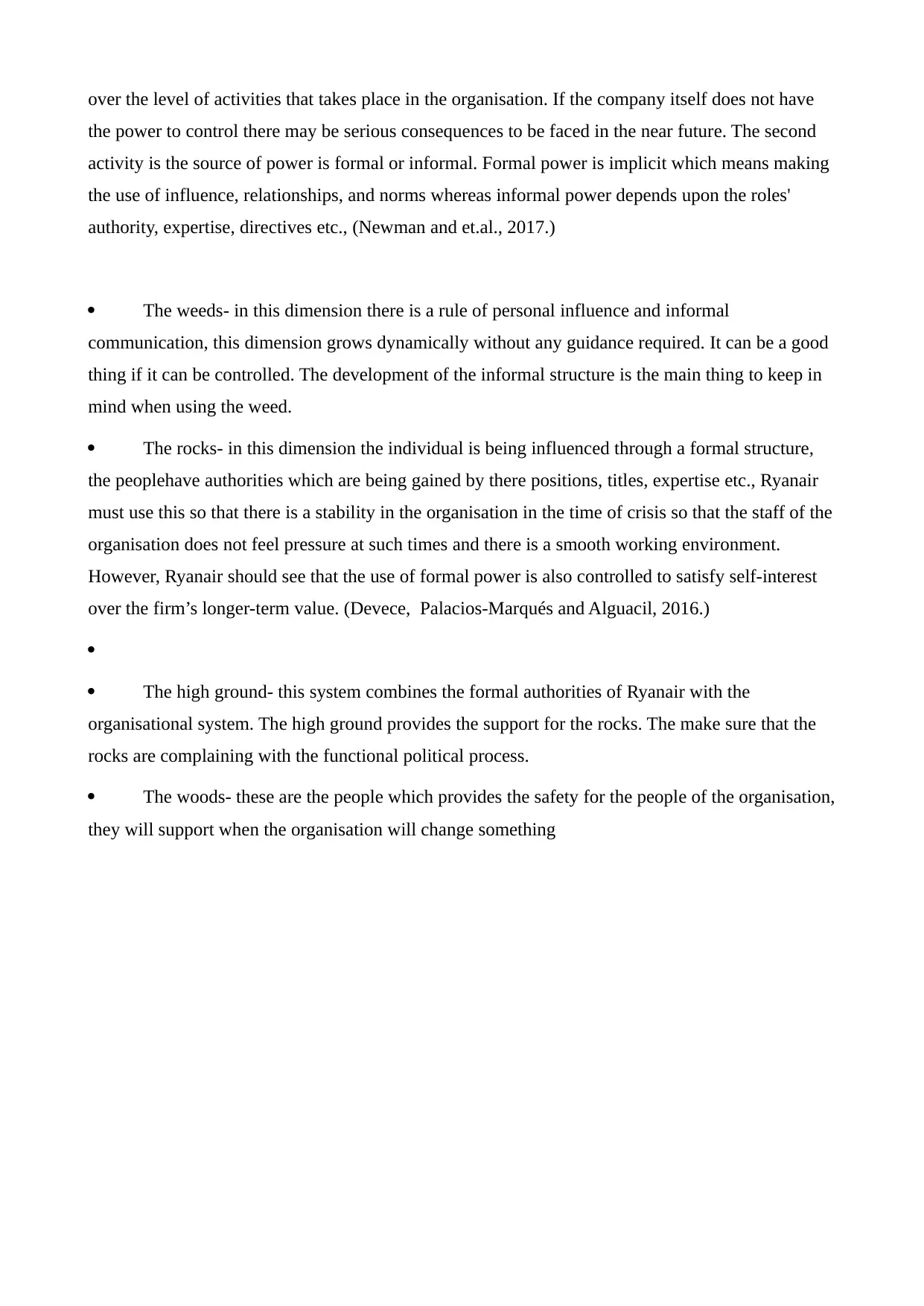
over the level of activities that takes place in the organisation. If the company itself does not have
the power to control there may be serious consequences to be faced in the near future. The second
activity is the source of power is formal or informal. Formal power is implicit which means making
the use of influence, relationships, and norms whereas informal power depends upon the roles'
authority, expertise, directives etc., (Newman and et.al., 2017.)
The weeds- in this dimension there is a rule of personal influence and informal
communication, this dimension grows dynamically without any guidance required. It can be a good
thing if it can be controlled. The development of the informal structure is the main thing to keep in
mind when using the weed.
The rocks- in this dimension the individual is being influenced through a formal structure,
the peoplehave authorities which are being gained by there positions, titles, expertise etc., Ryanair
must use this so that there is a stability in the organisation in the time of crisis so that the staff of the
organisation does not feel pressure at such times and there is a smooth working environment.
However, Ryanair should see that the use of formal power is also controlled to satisfy self-interest
over the firm’s longer-term value. (Devece, Palacios-Marqués and Alguacil, 2016.)
The high ground- this system combines the formal authorities of Ryanair with the
organisational system. The high ground provides the support for the rocks. The make sure that the
rocks are complaining with the functional political process.
The woods- these are the people which provides the safety for the people of the organisation,
they will support when the organisation will change something
the power to control there may be serious consequences to be faced in the near future. The second
activity is the source of power is formal or informal. Formal power is implicit which means making
the use of influence, relationships, and norms whereas informal power depends upon the roles'
authority, expertise, directives etc., (Newman and et.al., 2017.)
The weeds- in this dimension there is a rule of personal influence and informal
communication, this dimension grows dynamically without any guidance required. It can be a good
thing if it can be controlled. The development of the informal structure is the main thing to keep in
mind when using the weed.
The rocks- in this dimension the individual is being influenced through a formal structure,
the peoplehave authorities which are being gained by there positions, titles, expertise etc., Ryanair
must use this so that there is a stability in the organisation in the time of crisis so that the staff of the
organisation does not feel pressure at such times and there is a smooth working environment.
However, Ryanair should see that the use of formal power is also controlled to satisfy self-interest
over the firm’s longer-term value. (Devece, Palacios-Marqués and Alguacil, 2016.)
The high ground- this system combines the formal authorities of Ryanair with the
organisational system. The high ground provides the support for the rocks. The make sure that the
rocks are complaining with the functional political process.
The woods- these are the people which provides the safety for the people of the organisation,
they will support when the organisation will change something
Paraphrase This Document
Need a fresh take? Get an instant paraphrase of this document with our AI Paraphraser
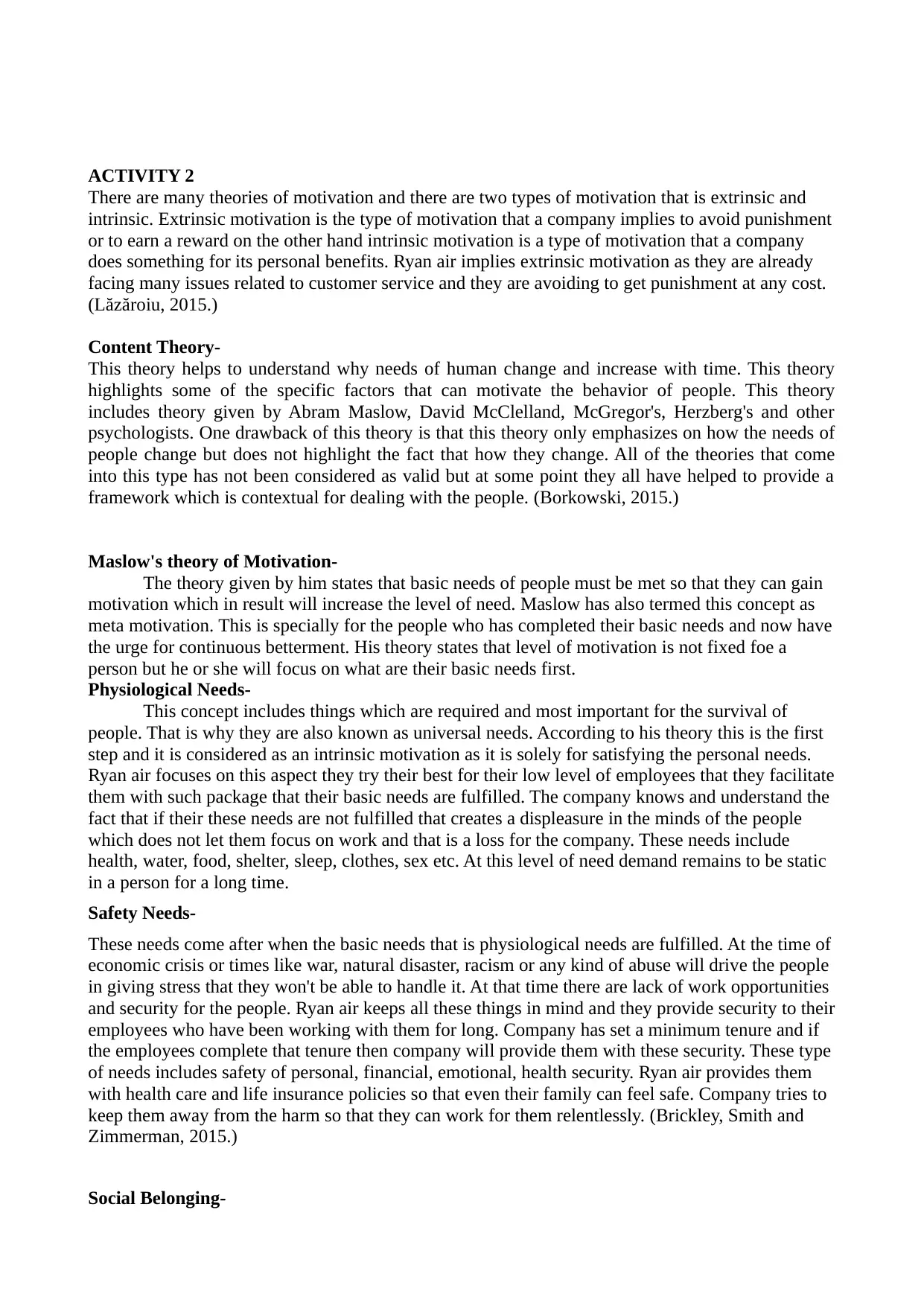
ACTIVITY 2
There are many theories of motivation and there are two types of motivation that is extrinsic and
intrinsic. Extrinsic motivation is the type of motivation that a company implies to avoid punishment
or to earn a reward on the other hand intrinsic motivation is a type of motivation that a company
does something for its personal benefits. Ryan air implies extrinsic motivation as they are already
facing many issues related to customer service and they are avoiding to get punishment at any cost.
(Lăzăroiu, 2015.)
Content Theory-
This theory helps to understand why needs of human change and increase with time. This theory
highlights some of the specific factors that can motivate the behavior of people. This theory
includes theory given by Abram Maslow, David McClelland, McGregor's, Herzberg's and other
psychologists. One drawback of this theory is that this theory only emphasizes on how the needs of
people change but does not highlight the fact that how they change. All of the theories that come
into this type has not been considered as valid but at some point they all have helped to provide a
framework which is contextual for dealing with the people. (Borkowski, 2015.)
Maslow's theory of Motivation-
The theory given by him states that basic needs of people must be met so that they can gain
motivation which in result will increase the level of need. Maslow has also termed this concept as
meta motivation. This is specially for the people who has completed their basic needs and now have
the urge for continuous betterment. His theory states that level of motivation is not fixed foe a
person but he or she will focus on what are their basic needs first.
Physiological Needs-
This concept includes things which are required and most important for the survival of
people. That is why they are also known as universal needs. According to his theory this is the first
step and it is considered as an intrinsic motivation as it is solely for satisfying the personal needs.
Ryan air focuses on this aspect they try their best for their low level of employees that they facilitate
them with such package that their basic needs are fulfilled. The company knows and understand the
fact that if their these needs are not fulfilled that creates a displeasure in the minds of the people
which does not let them focus on work and that is a loss for the company. These needs include
health, water, food, shelter, sleep, clothes, sex etc. At this level of need demand remains to be static
in a person for a long time.
Safety Needs-
These needs come after when the basic needs that is physiological needs are fulfilled. At the time of
economic crisis or times like war, natural disaster, racism or any kind of abuse will drive the people
in giving stress that they won't be able to handle it. At that time there are lack of work opportunities
and security for the people. Ryan air keeps all these things in mind and they provide security to their
employees who have been working with them for long. Company has set a minimum tenure and if
the employees complete that tenure then company will provide them with these security. These type
of needs includes safety of personal, financial, emotional, health security. Ryan air provides them
with health care and life insurance policies so that even their family can feel safe. Company tries to
keep them away from the harm so that they can work for them relentlessly. (Brickley, Smith and
Zimmerman, 2015.)
Social Belonging-
There are many theories of motivation and there are two types of motivation that is extrinsic and
intrinsic. Extrinsic motivation is the type of motivation that a company implies to avoid punishment
or to earn a reward on the other hand intrinsic motivation is a type of motivation that a company
does something for its personal benefits. Ryan air implies extrinsic motivation as they are already
facing many issues related to customer service and they are avoiding to get punishment at any cost.
(Lăzăroiu, 2015.)
Content Theory-
This theory helps to understand why needs of human change and increase with time. This theory
highlights some of the specific factors that can motivate the behavior of people. This theory
includes theory given by Abram Maslow, David McClelland, McGregor's, Herzberg's and other
psychologists. One drawback of this theory is that this theory only emphasizes on how the needs of
people change but does not highlight the fact that how they change. All of the theories that come
into this type has not been considered as valid but at some point they all have helped to provide a
framework which is contextual for dealing with the people. (Borkowski, 2015.)
Maslow's theory of Motivation-
The theory given by him states that basic needs of people must be met so that they can gain
motivation which in result will increase the level of need. Maslow has also termed this concept as
meta motivation. This is specially for the people who has completed their basic needs and now have
the urge for continuous betterment. His theory states that level of motivation is not fixed foe a
person but he or she will focus on what are their basic needs first.
Physiological Needs-
This concept includes things which are required and most important for the survival of
people. That is why they are also known as universal needs. According to his theory this is the first
step and it is considered as an intrinsic motivation as it is solely for satisfying the personal needs.
Ryan air focuses on this aspect they try their best for their low level of employees that they facilitate
them with such package that their basic needs are fulfilled. The company knows and understand the
fact that if their these needs are not fulfilled that creates a displeasure in the minds of the people
which does not let them focus on work and that is a loss for the company. These needs include
health, water, food, shelter, sleep, clothes, sex etc. At this level of need demand remains to be static
in a person for a long time.
Safety Needs-
These needs come after when the basic needs that is physiological needs are fulfilled. At the time of
economic crisis or times like war, natural disaster, racism or any kind of abuse will drive the people
in giving stress that they won't be able to handle it. At that time there are lack of work opportunities
and security for the people. Ryan air keeps all these things in mind and they provide security to their
employees who have been working with them for long. Company has set a minimum tenure and if
the employees complete that tenure then company will provide them with these security. These type
of needs includes safety of personal, financial, emotional, health security. Ryan air provides them
with health care and life insurance policies so that even their family can feel safe. Company tries to
keep them away from the harm so that they can work for them relentlessly. (Brickley, Smith and
Zimmerman, 2015.)
Social Belonging-
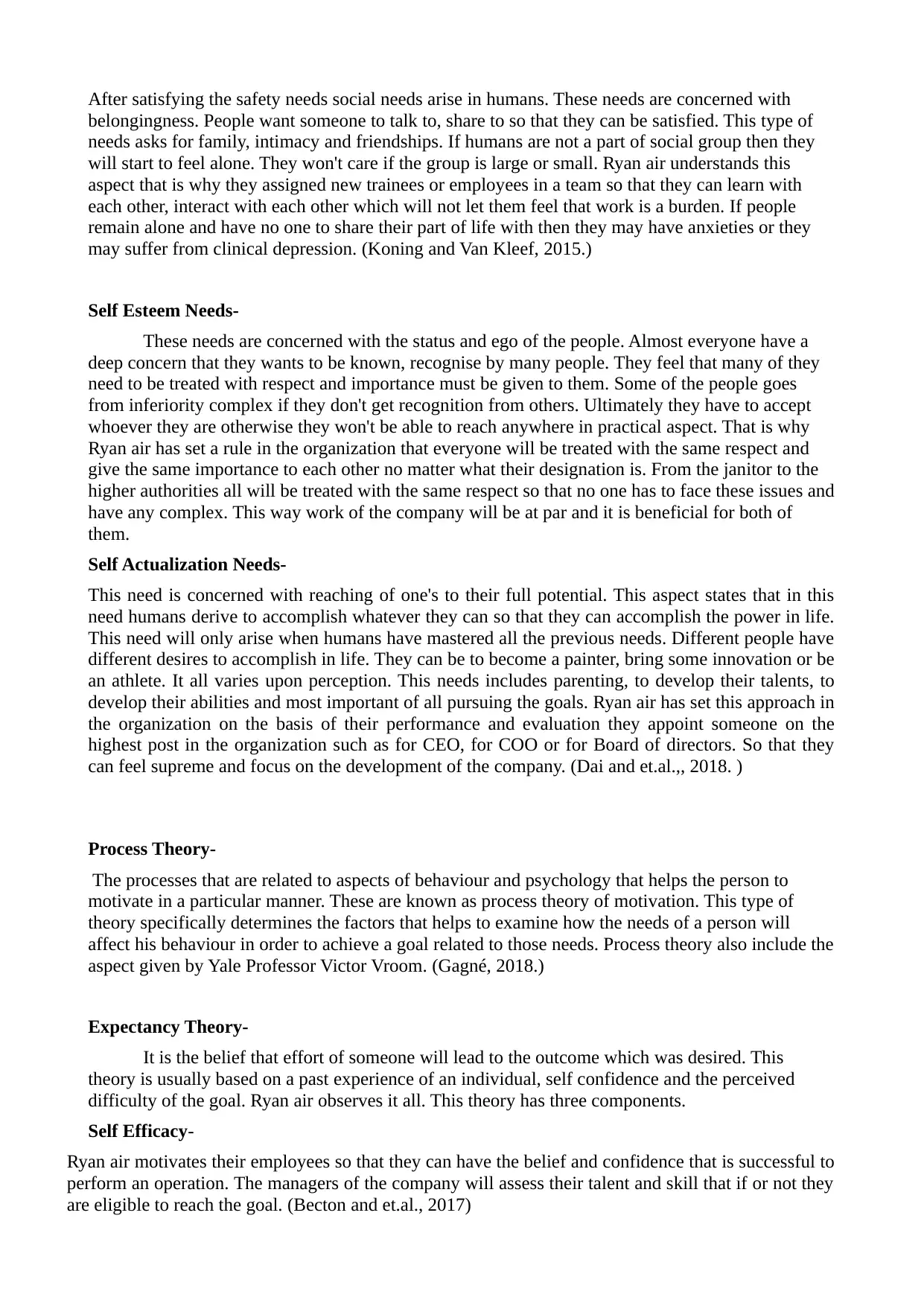
After satisfying the safety needs social needs arise in humans. These needs are concerned with
belongingness. People want someone to talk to, share to so that they can be satisfied. This type of
needs asks for family, intimacy and friendships. If humans are not a part of social group then they
will start to feel alone. They won't care if the group is large or small. Ryan air understands this
aspect that is why they assigned new trainees or employees in a team so that they can learn with
each other, interact with each other which will not let them feel that work is a burden. If people
remain alone and have no one to share their part of life with then they may have anxieties or they
may suffer from clinical depression. (Koning and Van Kleef, 2015.)
Self Esteem Needs-
These needs are concerned with the status and ego of the people. Almost everyone have a
deep concern that they wants to be known, recognise by many people. They feel that many of they
need to be treated with respect and importance must be given to them. Some of the people goes
from inferiority complex if they don't get recognition from others. Ultimately they have to accept
whoever they are otherwise they won't be able to reach anywhere in practical aspect. That is why
Ryan air has set a rule in the organization that everyone will be treated with the same respect and
give the same importance to each other no matter what their designation is. From the janitor to the
higher authorities all will be treated with the same respect so that no one has to face these issues and
have any complex. This way work of the company will be at par and it is beneficial for both of
them.
Self Actualization Needs-
This need is concerned with reaching of one's to their full potential. This aspect states that in this
need humans derive to accomplish whatever they can so that they can accomplish the power in life.
This need will only arise when humans have mastered all the previous needs. Different people have
different desires to accomplish in life. They can be to become a painter, bring some innovation or be
an athlete. It all varies upon perception. This needs includes parenting, to develop their talents, to
develop their abilities and most important of all pursuing the goals. Ryan air has set this approach in
the organization on the basis of their performance and evaluation they appoint someone on the
highest post in the organization such as for CEO, for COO or for Board of directors. So that they
can feel supreme and focus on the development of the company. (Dai and et.al.,, 2018. )
Process Theory-
The processes that are related to aspects of behaviour and psychology that helps the person to
motivate in a particular manner. These are known as process theory of motivation. This type of
theory specifically determines the factors that helps to examine how the needs of a person will
affect his behaviour in order to achieve a goal related to those needs. Process theory also include the
aspect given by Yale Professor Victor Vroom. (Gagné, 2018.)
Expectancy Theory-
It is the belief that effort of someone will lead to the outcome which was desired. This
theory is usually based on a past experience of an individual, self confidence and the perceived
difficulty of the goal. Ryan air observes it all. This theory has three components.
Self Efficacy-
Ryan air motivates their employees so that they can have the belief and confidence that is successful to
perform an operation. The managers of the company will assess their talent and skill that if or not they
are eligible to reach the goal. (Becton and et.al., 2017)
belongingness. People want someone to talk to, share to so that they can be satisfied. This type of
needs asks for family, intimacy and friendships. If humans are not a part of social group then they
will start to feel alone. They won't care if the group is large or small. Ryan air understands this
aspect that is why they assigned new trainees or employees in a team so that they can learn with
each other, interact with each other which will not let them feel that work is a burden. If people
remain alone and have no one to share their part of life with then they may have anxieties or they
may suffer from clinical depression. (Koning and Van Kleef, 2015.)
Self Esteem Needs-
These needs are concerned with the status and ego of the people. Almost everyone have a
deep concern that they wants to be known, recognise by many people. They feel that many of they
need to be treated with respect and importance must be given to them. Some of the people goes
from inferiority complex if they don't get recognition from others. Ultimately they have to accept
whoever they are otherwise they won't be able to reach anywhere in practical aspect. That is why
Ryan air has set a rule in the organization that everyone will be treated with the same respect and
give the same importance to each other no matter what their designation is. From the janitor to the
higher authorities all will be treated with the same respect so that no one has to face these issues and
have any complex. This way work of the company will be at par and it is beneficial for both of
them.
Self Actualization Needs-
This need is concerned with reaching of one's to their full potential. This aspect states that in this
need humans derive to accomplish whatever they can so that they can accomplish the power in life.
This need will only arise when humans have mastered all the previous needs. Different people have
different desires to accomplish in life. They can be to become a painter, bring some innovation or be
an athlete. It all varies upon perception. This needs includes parenting, to develop their talents, to
develop their abilities and most important of all pursuing the goals. Ryan air has set this approach in
the organization on the basis of their performance and evaluation they appoint someone on the
highest post in the organization such as for CEO, for COO or for Board of directors. So that they
can feel supreme and focus on the development of the company. (Dai and et.al.,, 2018. )
Process Theory-
The processes that are related to aspects of behaviour and psychology that helps the person to
motivate in a particular manner. These are known as process theory of motivation. This type of
theory specifically determines the factors that helps to examine how the needs of a person will
affect his behaviour in order to achieve a goal related to those needs. Process theory also include the
aspect given by Yale Professor Victor Vroom. (Gagné, 2018.)
Expectancy Theory-
It is the belief that effort of someone will lead to the outcome which was desired. This
theory is usually based on a past experience of an individual, self confidence and the perceived
difficulty of the goal. Ryan air observes it all. This theory has three components.
Self Efficacy-
Ryan air motivates their employees so that they can have the belief and confidence that is successful to
perform an operation. The managers of the company will assess their talent and skill that if or not they
are eligible to reach the goal. (Becton and et.al., 2017)
⊘ This is a preview!⊘
Do you want full access?
Subscribe today to unlock all pages.

Trusted by 1+ million students worldwide
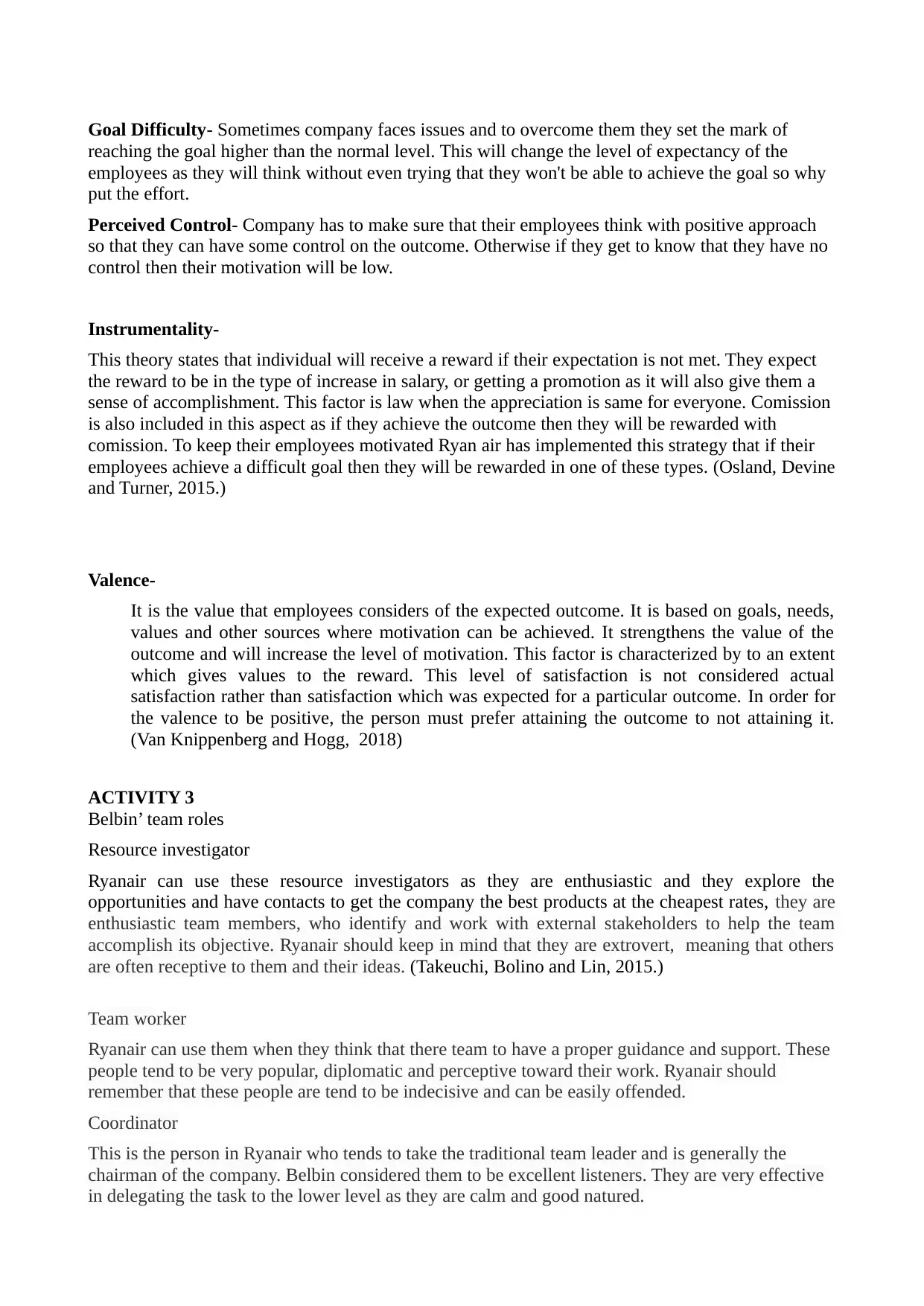
Goal Difficulty- Sometimes company faces issues and to overcome them they set the mark of
reaching the goal higher than the normal level. This will change the level of expectancy of the
employees as they will think without even trying that they won't be able to achieve the goal so why
put the effort.
Perceived Control- Company has to make sure that their employees think with positive approach
so that they can have some control on the outcome. Otherwise if they get to know that they have no
control then their motivation will be low.
Instrumentality-
This theory states that individual will receive a reward if their expectation is not met. They expect
the reward to be in the type of increase in salary, or getting a promotion as it will also give them a
sense of accomplishment. This factor is law when the appreciation is same for everyone. Comission
is also included in this aspect as if they achieve the outcome then they will be rewarded with
comission. To keep their employees motivated Ryan air has implemented this strategy that if their
employees achieve a difficult goal then they will be rewarded in one of these types. (Osland, Devine
and Turner, 2015.)
Valence-
It is the value that employees considers of the expected outcome. It is based on goals, needs,
values and other sources where motivation can be achieved. It strengthens the value of the
outcome and will increase the level of motivation. This factor is characterized by to an extent
which gives values to the reward. This level of satisfaction is not considered actual
satisfaction rather than satisfaction which was expected for a particular outcome. In order for
the valence to be positive, the person must prefer attaining the outcome to not attaining it.
(Van Knippenberg and Hogg, 2018)
ACTIVITY 3
Belbin’ team roles
Resource investigator
Ryanair can use these resource investigators as they are enthusiastic and they explore the
opportunities and have contacts to get the company the best products at the cheapest rates, they are
enthusiastic team members, who identify and work with external stakeholders to help the team
accomplish its objective. Ryanair should keep in mind that they are extrovert, meaning that others
are often receptive to them and their ideas. (Takeuchi, Bolino and Lin, 2015.)
Team worker
Ryanair can use them when they think that there team to have a proper guidance and support. These
people tend to be very popular, diplomatic and perceptive toward their work. Ryanair should
remember that these people are tend to be indecisive and can be easily offended.
Coordinator
This is the person in Ryanair who tends to take the traditional team leader and is generally the
chairman of the company. Belbin considered them to be excellent listeners. They are very effective
in delegating the task to the lower level as they are calm and good natured.
reaching the goal higher than the normal level. This will change the level of expectancy of the
employees as they will think without even trying that they won't be able to achieve the goal so why
put the effort.
Perceived Control- Company has to make sure that their employees think with positive approach
so that they can have some control on the outcome. Otherwise if they get to know that they have no
control then their motivation will be low.
Instrumentality-
This theory states that individual will receive a reward if their expectation is not met. They expect
the reward to be in the type of increase in salary, or getting a promotion as it will also give them a
sense of accomplishment. This factor is law when the appreciation is same for everyone. Comission
is also included in this aspect as if they achieve the outcome then they will be rewarded with
comission. To keep their employees motivated Ryan air has implemented this strategy that if their
employees achieve a difficult goal then they will be rewarded in one of these types. (Osland, Devine
and Turner, 2015.)
Valence-
It is the value that employees considers of the expected outcome. It is based on goals, needs,
values and other sources where motivation can be achieved. It strengthens the value of the
outcome and will increase the level of motivation. This factor is characterized by to an extent
which gives values to the reward. This level of satisfaction is not considered actual
satisfaction rather than satisfaction which was expected for a particular outcome. In order for
the valence to be positive, the person must prefer attaining the outcome to not attaining it.
(Van Knippenberg and Hogg, 2018)
ACTIVITY 3
Belbin’ team roles
Resource investigator
Ryanair can use these resource investigators as they are enthusiastic and they explore the
opportunities and have contacts to get the company the best products at the cheapest rates, they are
enthusiastic team members, who identify and work with external stakeholders to help the team
accomplish its objective. Ryanair should keep in mind that they are extrovert, meaning that others
are often receptive to them and their ideas. (Takeuchi, Bolino and Lin, 2015.)
Team worker
Ryanair can use them when they think that there team to have a proper guidance and support. These
people tend to be very popular, diplomatic and perceptive toward their work. Ryanair should
remember that these people are tend to be indecisive and can be easily offended.
Coordinator
This is the person in Ryanair who tends to take the traditional team leader and is generally the
chairman of the company. Belbin considered them to be excellent listeners. They are very effective
in delegating the task to the lower level as they are calm and good natured.
Paraphrase This Document
Need a fresh take? Get an instant paraphrase of this document with our AI Paraphraser

Shaper
These are the person who will challenge their team to increase their efficiency. They are extroverts
who can easily communicate with other peoples. Ryanair can use them when they wants to shakes
the working of their organisation or when they are changing the way of doing work. Ryanair should
keep in mind that these shaper may sometimes be very argumentative.
Implementer
These are the people who actually get the work in an organisation. Ryanair can use them so that
they can covert there plans and concepts in the action so that they can achieve their goals. Ryanair
can always rely upon them to get the task done. The possible weakness of implementer that Ryanair
can face is that they are inflexible. (Podsakoff, MacKenzie and Podsakoff, 2018.)
Completer finisher
These are the people who sees that the project is done effectively. Ryanair can use the completer
finisher so that they can check that the work beinf=g done by the employees are free from errors
and mistakes. There possible weaknesses in at times they may worry unnecessarily and may find it
hard the task to be delegated.
Plants
These are the creative people in the organisation. Ryanair can use these type of employees so that
they can find new ways of completing the work effectively and efficiently. This will lead to Ryanair
completing the task as soon as they can. The possible downside that Ryanair may face is that they
are not good communicators. (Kinicki and Fugate, 2017.)
Specialist
The people who have special knowledge in an area and which can be beneficial for the organisation
at times when they faces complex problems. these are the people who takes pride in what they do
and how they work, the possible weaknesses are they might get so preoccupied with there work that
they forget the picture of the whole organisation.
Dr Bruce Tuckman published his Forming Storming Norming Performing model in 1965. He added
a fifth stage, Adjourning, in the 1970s. The Forming Storming Norming Performing theory is an
elegant and helpful explanation of team development and behaviour (US spelling: behaviour ).
Similarities can be seen with other models, such as Tannenbaum and Schmidt Continuum and
especially with Hersey and Blanchard's Situational Leadership model, developed about the same
time.
Tuckman's model explains that as Ryanair develops maturity and ability, relationships establish, and
the leader changes leadership style. Beginning with a directing style, moving through
coaching, then participating, finishing delegating and almost detached. At this point Ryanair
may produce a successor leader and the previous leader can move on to develop a new team.
This progression of team behaviour and leadership style can be seen clearly in the
Tannenbaum and Schmidt Continuum - the authority and freedom extended by the leader to
Ryanair increases while the control of the leader reduces. (Borkowski, 2016)
There are 5 stages in Tuckman’s Theory which are :
1.Forming
2.Storming
3.Norming
4.Performing
5. Adjourning
These are the person who will challenge their team to increase their efficiency. They are extroverts
who can easily communicate with other peoples. Ryanair can use them when they wants to shakes
the working of their organisation or when they are changing the way of doing work. Ryanair should
keep in mind that these shaper may sometimes be very argumentative.
Implementer
These are the people who actually get the work in an organisation. Ryanair can use them so that
they can covert there plans and concepts in the action so that they can achieve their goals. Ryanair
can always rely upon them to get the task done. The possible weakness of implementer that Ryanair
can face is that they are inflexible. (Podsakoff, MacKenzie and Podsakoff, 2018.)
Completer finisher
These are the people who sees that the project is done effectively. Ryanair can use the completer
finisher so that they can check that the work beinf=g done by the employees are free from errors
and mistakes. There possible weaknesses in at times they may worry unnecessarily and may find it
hard the task to be delegated.
Plants
These are the creative people in the organisation. Ryanair can use these type of employees so that
they can find new ways of completing the work effectively and efficiently. This will lead to Ryanair
completing the task as soon as they can. The possible downside that Ryanair may face is that they
are not good communicators. (Kinicki and Fugate, 2017.)
Specialist
The people who have special knowledge in an area and which can be beneficial for the organisation
at times when they faces complex problems. these are the people who takes pride in what they do
and how they work, the possible weaknesses are they might get so preoccupied with there work that
they forget the picture of the whole organisation.
Dr Bruce Tuckman published his Forming Storming Norming Performing model in 1965. He added
a fifth stage, Adjourning, in the 1970s. The Forming Storming Norming Performing theory is an
elegant and helpful explanation of team development and behaviour (US spelling: behaviour ).
Similarities can be seen with other models, such as Tannenbaum and Schmidt Continuum and
especially with Hersey and Blanchard's Situational Leadership model, developed about the same
time.
Tuckman's model explains that as Ryanair develops maturity and ability, relationships establish, and
the leader changes leadership style. Beginning with a directing style, moving through
coaching, then participating, finishing delegating and almost detached. At this point Ryanair
may produce a successor leader and the previous leader can move on to develop a new team.
This progression of team behaviour and leadership style can be seen clearly in the
Tannenbaum and Schmidt Continuum - the authority and freedom extended by the leader to
Ryanair increases while the control of the leader reduces. (Borkowski, 2016)
There are 5 stages in Tuckman’s Theory which are :
1.Forming
2.Storming
3.Norming
4.Performing
5. Adjourning
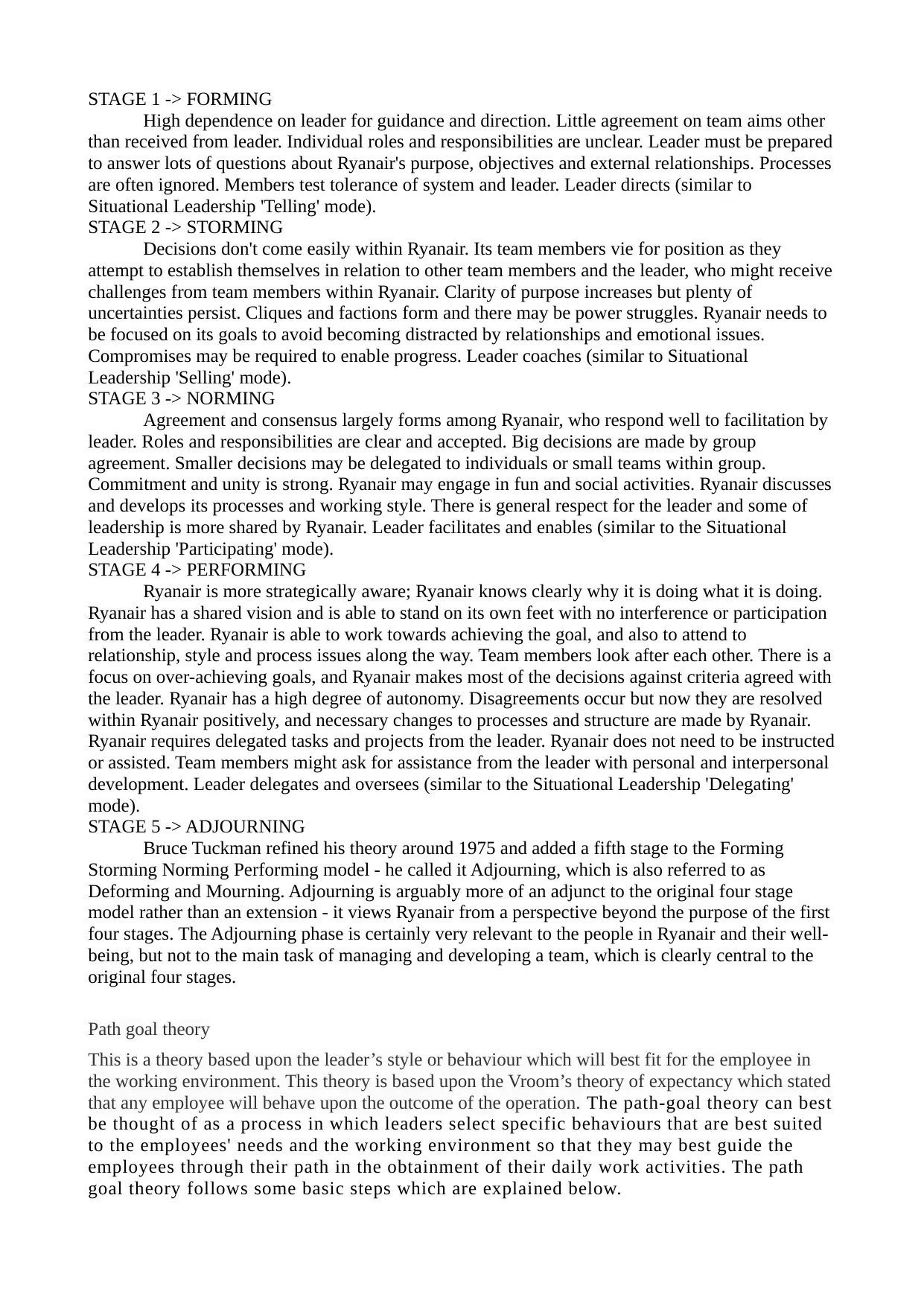
STAGE 1 -> FORMING
High dependence on leader for guidance and direction. Little agreement on team aims other
than received from leader. Individual roles and responsibilities are unclear. Leader must be prepared
to answer lots of questions about Ryanair's purpose, objectives and external relationships. Processes
are often ignored. Members test tolerance of system and leader. Leader directs (similar to
Situational Leadership 'Telling' mode).
STAGE 2 -> STORMING
Decisions don't come easily within Ryanair. Its team members vie for position as they
attempt to establish themselves in relation to other team members and the leader, who might receive
challenges from team members within Ryanair. Clarity of purpose increases but plenty of
uncertainties persist. Cliques and factions form and there may be power struggles. Ryanair needs to
be focused on its goals to avoid becoming distracted by relationships and emotional issues.
Compromises may be required to enable progress. Leader coaches (similar to Situational
Leadership 'Selling' mode).
STAGE 3 -> NORMING
Agreement and consensus largely forms among Ryanair, who respond well to facilitation by
leader. Roles and responsibilities are clear and accepted. Big decisions are made by group
agreement. Smaller decisions may be delegated to individuals or small teams within group.
Commitment and unity is strong. Ryanair may engage in fun and social activities. Ryanair discusses
and develops its processes and working style. There is general respect for the leader and some of
leadership is more shared by Ryanair. Leader facilitates and enables (similar to the Situational
Leadership 'Participating' mode).
STAGE 4 -> PERFORMING
Ryanair is more strategically aware; Ryanair knows clearly why it is doing what it is doing.
Ryanair has a shared vision and is able to stand on its own feet with no interference or participation
from the leader. Ryanair is able to work towards achieving the goal, and also to attend to
relationship, style and process issues along the way. Team members look after each other. There is a
focus on over-achieving goals, and Ryanair makes most of the decisions against criteria agreed with
the leader. Ryanair has a high degree of autonomy. Disagreements occur but now they are resolved
within Ryanair positively, and necessary changes to processes and structure are made by Ryanair.
Ryanair requires delegated tasks and projects from the leader. Ryanair does not need to be instructed
or assisted. Team members might ask for assistance from the leader with personal and interpersonal
development. Leader delegates and oversees (similar to the Situational Leadership 'Delegating'
mode).
STAGE 5 -> ADJOURNING
Bruce Tuckman refined his theory around 1975 and added a fifth stage to the Forming
Storming Norming Performing model - he called it Adjourning, which is also referred to as
Deforming and Mourning. Adjourning is arguably more of an adjunct to the original four stage
model rather than an extension - it views Ryanair from a perspective beyond the purpose of the first
four stages. The Adjourning phase is certainly very relevant to the people in Ryanair and their well-
being, but not to the main task of managing and developing a team, which is clearly central to the
original four stages.
Path goal theory
This is a theory based upon the leader’s style or behaviour which will best fit for the employee in
the working environment. This theory is based upon the Vroom’s theory of expectancy which stated
that any employee will behave upon the outcome of the operation. The path-goal theory can best
be thought of as a process in which leaders select specific behaviours that are best suited
to the employees' needs and the working environment so that they may best guide the
employees through their path in the obtainment of their daily work activities. The path
goal theory follows some basic steps which are explained below.
High dependence on leader for guidance and direction. Little agreement on team aims other
than received from leader. Individual roles and responsibilities are unclear. Leader must be prepared
to answer lots of questions about Ryanair's purpose, objectives and external relationships. Processes
are often ignored. Members test tolerance of system and leader. Leader directs (similar to
Situational Leadership 'Telling' mode).
STAGE 2 -> STORMING
Decisions don't come easily within Ryanair. Its team members vie for position as they
attempt to establish themselves in relation to other team members and the leader, who might receive
challenges from team members within Ryanair. Clarity of purpose increases but plenty of
uncertainties persist. Cliques and factions form and there may be power struggles. Ryanair needs to
be focused on its goals to avoid becoming distracted by relationships and emotional issues.
Compromises may be required to enable progress. Leader coaches (similar to Situational
Leadership 'Selling' mode).
STAGE 3 -> NORMING
Agreement and consensus largely forms among Ryanair, who respond well to facilitation by
leader. Roles and responsibilities are clear and accepted. Big decisions are made by group
agreement. Smaller decisions may be delegated to individuals or small teams within group.
Commitment and unity is strong. Ryanair may engage in fun and social activities. Ryanair discusses
and develops its processes and working style. There is general respect for the leader and some of
leadership is more shared by Ryanair. Leader facilitates and enables (similar to the Situational
Leadership 'Participating' mode).
STAGE 4 -> PERFORMING
Ryanair is more strategically aware; Ryanair knows clearly why it is doing what it is doing.
Ryanair has a shared vision and is able to stand on its own feet with no interference or participation
from the leader. Ryanair is able to work towards achieving the goal, and also to attend to
relationship, style and process issues along the way. Team members look after each other. There is a
focus on over-achieving goals, and Ryanair makes most of the decisions against criteria agreed with
the leader. Ryanair has a high degree of autonomy. Disagreements occur but now they are resolved
within Ryanair positively, and necessary changes to processes and structure are made by Ryanair.
Ryanair requires delegated tasks and projects from the leader. Ryanair does not need to be instructed
or assisted. Team members might ask for assistance from the leader with personal and interpersonal
development. Leader delegates and oversees (similar to the Situational Leadership 'Delegating'
mode).
STAGE 5 -> ADJOURNING
Bruce Tuckman refined his theory around 1975 and added a fifth stage to the Forming
Storming Norming Performing model - he called it Adjourning, which is also referred to as
Deforming and Mourning. Adjourning is arguably more of an adjunct to the original four stage
model rather than an extension - it views Ryanair from a perspective beyond the purpose of the first
four stages. The Adjourning phase is certainly very relevant to the people in Ryanair and their well-
being, but not to the main task of managing and developing a team, which is clearly central to the
original four stages.
Path goal theory
This is a theory based upon the leader’s style or behaviour which will best fit for the employee in
the working environment. This theory is based upon the Vroom’s theory of expectancy which stated
that any employee will behave upon the outcome of the operation. The path-goal theory can best
be thought of as a process in which leaders select specific behaviours that are best suited
to the employees' needs and the working environment so that they may best guide the
employees through their path in the obtainment of their daily work activities. The path
goal theory follows some basic steps which are explained below.
⊘ This is a preview!⊘
Do you want full access?
Subscribe today to unlock all pages.

Trusted by 1+ million students worldwide
1 out of 16
Related Documents
Your All-in-One AI-Powered Toolkit for Academic Success.
+13062052269
info@desklib.com
Available 24*7 on WhatsApp / Email
![[object Object]](/_next/static/media/star-bottom.7253800d.svg)
Unlock your academic potential
Copyright © 2020–2025 A2Z Services. All Rights Reserved. Developed and managed by ZUCOL.





